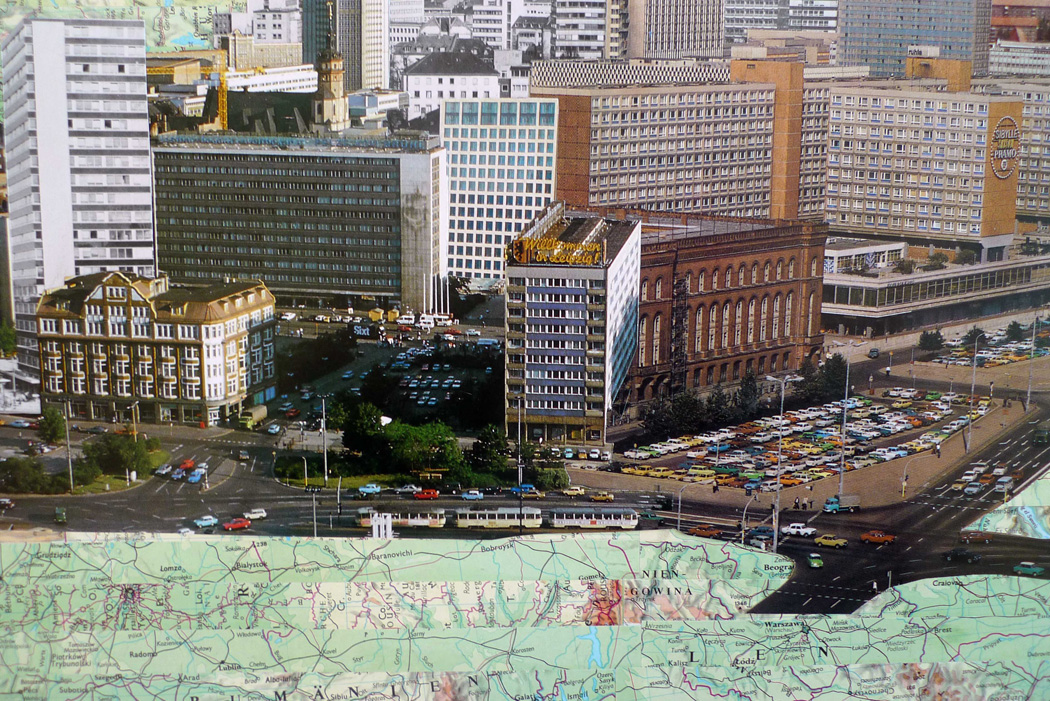Denis Schäfer is one of the most amazing collage artists I have come across in a long time. He was born in 1973 in Langen near Frankfurt / Main and has lived in Berlin since 1996. After his museology studies, he turned to teaching himself the photography and the design of paper collages, which he in a traditional manner – produces with motifs from newspapers, magazines and other print media – with scissors, glue and paper.
His works leads the viewer into urban spaces that blur the border between reality and fiction, and their the origins are not to be located temporally and geographically.
KALTBLUT: Why did you opt for collages? What got you interested in them?
Denis: A coincidence. For years I have been collecting newspaper and magazine illustrations that fascinate me in a special way in a big box. The illustrations are quite different: A Majority are pictures of buildings and architecture but there are also people, mountains, landscapes, birds, skies, cars and machinery. When I went from Berlin to Munich in 2006, I noticed the box and I began to put the illustrations together in collages. My first collages were created in 2006 on cold, dark but cozy winter nights in Munich. Since then it has become my passion to work with paper and glue. Important to me is that the parts of completely different sources fit together and can be put into a relationship in a collage. The more parts match together in perspective, proportion and color, the more interesting is the work. Sometimes it takes a long time, till a collage is completed. I cut and paste with scissors and glue. Each clipping is normally present only once and each collage is unique. In this context, I offer no prints of my collages. I find the character and structure of the individual papercollage in copy or print gets lost. I only use clippings from newspapers, magazines and sometimes my own photography.
KALTBLUT: How do you think collages are different to other forms of art?
Denis: A clear advantage over the painting: The motives are already present. I have not to think about the individual motives. The pictures are available and must be placed in a new order.
KALTBLUT: What sort of images inspire you? How do you know “this is an image I want to use!”?
Denis: This is a difficult question, because usually I have the idea first and then I follow to translate it into a collage. I have a photographic memory and I know very well, which clippings are in my collection. I can quickly determine if a cutout fits to another. That’s a really good beginning! If one part is missing to complete the collage, I have to be patient. Sometimes there is also one extraordinary image that becomes the beginning of a collage. It is different.
KALTBLUT: I see a lot of city scapes. Why city scapes? What’s your favourite city you have been to?
Denis: I like architecture and city development. To create Cities, Places and Landscapes in my collages, like the MEGAURBANPOLIS-series let me get in touch with this material. There are so many extraordinary and awesome buildings and architecture in the world and I like to bring them together and create urban spaces that blur the border between reality and fiction. It is also a question, how today cities in their architecture are different from each other? I also want to examine in my work current topics, such as urban-gardening, or gentrification and city tourism.
I think about: how will the quality of life in the city be? Where will citizens live in famous cities in Europe in the future? In one old musealized and touristic downtown or in homes on the edges of metropolitan areas? I do not really have a favorite city, but i think, Berlin is a dynamic, beautiful cultural city, where the development is not yet complete and a good place to be.
Interview by Amanda M. Jansson
Contact:







